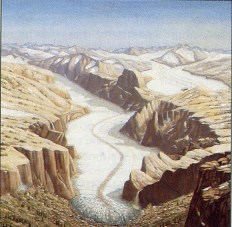
A 1921 view taken by George Mallory of the Main Rongbuk Glacier (left), on the northern slope of Mount Everest and a 2007 view of the same glacier taken by David Breashears, courtesy of GlacierWorks. Decades of pollution and global warming appear to have left the glacier shrunken and withered. (AFP/Asia Society)
Navigation: use the links below to view more comments.
first 1-20, 21-27 next last
To: NormsRevenge
Looks about the same if not bigger to me......
2 posted on
07/16/2010 2:12:33 PM PDT by
IamCenny
To: NormsRevenge
Yep, those pesky glaciers have been retreating unabated ever since the last ice age. We just noticed the last 80 years’ worth.
3 posted on
07/16/2010 2:12:41 PM PDT by
Yo-Yo
(Is the /sarc tag really necessary?)
To: NormsRevenge
Are you kidding me? I don’t see any major differences between the two photos at all. What I do see are some minor differences in ice and snow coverage and some illusions created by black and white vs color, and by the difference in exposure (such as an area on the slope to the left that appears to be snow or ice in the 1921 photo, but which is actually just a difference in shading of the dirt or rock below it.
As far as the glacier, it actually looks wider today to me than it did in 1921. Am I missing something?
4 posted on
07/16/2010 2:16:37 PM PDT by
noiseman
(The only thing necessary for the triumph of evil is for good men to do nothing.)
To: NormsRevenge
To: NormsRevenge
Seems to me that any ‘warmth’ would have affected the whole area. When you look at the outlines of the other areas -— they seem the same. What time of year were the first pics and what time the 2nd?
6 posted on
07/16/2010 2:19:12 PM PDT by
Exit148
(Loose Change Club Founder. Save your pennies for the next Freepathon. A little goes a long way!)
To: NormsRevenge
And the Abominable Snowman will have nowhere to go!
7 posted on
07/16/2010 2:20:47 PM PDT by
NaughtiusMaximus
(Social Justice is the right to refuse to buy them the rope they want to hang you with.)
To: NormsRevenge
Were these shot at the same time of the year?
They were clearly not shot with the same type of gear or film.
The B&W shot was shot with orthochromatic film, which was not sensitive to all colors in the spectrum.
On top of that, the two photos were shot with different focal length lenses, with changes most evident in the foreground.
9 posted on
07/16/2010 2:21:29 PM PDT by
MediaMole
To: NormsRevenge
In the 11th and 12th centuries, Vikings were living on the West coast of Greenland growing row crops and raising livestock outdoors. Seal and Walrus hunters ventured high into the Arctic in search of prey as late as October. Archaeological findings show Western explorers overwintered on the north coasts of Baffin Island and Hudson Bay.
10 posted on
07/16/2010 2:21:56 PM PDT by
CholeraJoe
("What did the English ever give you? Muffins and a burnt White House. ")
To: NormsRevenge
Instead of the powerful, white, S-shaped sweep of ice witnessed by Mallory before he died on his conquest of Everest, the Main Rongbuk Glacier today is shrunken and withered. Proof! Proof! that we need to elect more Democrats. Don't delay, the fate of the entire solar system depends upon it.
11 posted on
07/16/2010 2:22:51 PM PDT by
marron
To: NormsRevenge

Guess I'd better increase the output on my ice maker!
12 posted on
07/16/2010 2:24:59 PM PDT by
Diana in Wisconsin
(Save the Earth. It's the only planet with Chocolate.)
To: NormsRevenge
Yosemite Valley used to be full of ice fields and glaciers, but they are now all gone. Shame on the industrialists and polluters!

To: NormsRevenge
To: NormsRevenge
Were the pictures both taken at the same time of the year? Were the preceding snowy periods as heavy?
19 posted on
07/16/2010 2:30:40 PM PDT by
Mike Darancette
(Socialism is the philosophy of failure, - W Churchill)
To: NormsRevenge
Here's a picture of Everest's north face taken in 1924, showing less snow on the peak than in either Mallory's 1921 shot or the recent image:

To: NormsRevenge
Somehow I’ve misplaced the snapshots I took back “in the day” when glaciers covered Central Park in NYC and scooped out the Great Lakes. But any comparison pictures now would show they’re long gone due to “global warming.”
22 posted on
07/16/2010 2:33:52 PM PDT by
Bernard Marx
(I donÂ’t trust the reasoning of anyone who writes then when they mean than.)
To: NormsRevenge
“Instead of the powerful, white, S-shaped sweep of ice witnessed by Mallory before he died on his conquest of Everest, the Main Rongbuk Glacier today is shrunken and withered.”
Ooooh I love, love love hyperbole!
23 posted on
07/16/2010 2:35:44 PM PDT by
DariusBane
(Even the Rocks shall cry out "Hobamma to the Highest")
To: NormsRevenge
The Fox Glacier in New Zealand has been receding for the last 250 years. The first sign when you go up the trail shows you where the glacier was in 1775, next sign about 1/2 mile up the trail and it was there in 1850. Go a bit farther and there is the Fox Glacier, a mere shadow of it's former self. Those SUV’s 200 years ago really did a number on poor Foxie.
25 posted on
07/16/2010 2:41:35 PM PDT by
Ditter
To: SteamShovel; Desdemona; grey_whiskers; proud_yank; Horusra; Thunder90; Dr. Bogus Pachysandra; ...

Beam me to Planet Gore ! While currently some glaciers are retreating there are others which are thickening.
List of advancing glaciers. That is historically consistent ... good grief, the earth has seen Ice Ages retreat long before there were SUVs. Not so long ago the Snows of Kilimanjaro were a "hot" topic. Pat Michaels addressed that.

Consider the research of Ohio State University glaciologist Lonnie Thompson ... he who predicted in a 10/02 paper in Science an end to Kilimanjaro's glaciers by 2020, more or less, according to current trends. I remember when ABC news picked this up. Well. much of modern environmental journalism displays a pervasive lack of critical insight toward environmental scares and the scientific papers on which they are supposedly based. An inspection of Thompson's own data, also published in Science, shows that Kilimanjaro's glaciers would be dying even if Homo sapiens ancestors were still the dominant hominid in the Rift Valley, a few hundred miles to the West. That is to say, humans are not to blame for the glacial recession.
Thonpson cited five surveys of Kilimanjaro from 1912, 1953, 1976, 1989, and 2000, as per your graphic.
From 1912 to 1953, global temperatures rose (as measured controversially by surface thermometers) 0.4° C (0.74° F). This rise occurred before most of the industrial emissions of so-called "greenhouse gases" , mainly CO2 and CH4. As a result. most scientists think the warming of the 20th century had mainly to do with changes in Mr. Sun. In fact, slight changes in solar output have modulated the earth's surface temperature plus or minus about 1.0° C (1.8° F) over millennia.
Kilimanjaro's glaciers lost 45% of their areal extent during that era of solar warming. If the glaciers had continued to decline at the pace established in that period, they would already be gone by now, pfffft, even with no additional warming from the emissions of greenhouse gases.
But the glaciers are still here. From 1953 through 1976, another 21 percent of the original area was uncovered. This occurred during a period of global cooling of 0.07° C (0.13° F). OSU's press office could logically have written the following hype in 1976: "Kilimanjaro's glaciers will completely disappear by 2015 if this cooling trend continues".
It is patently obvious that global temperatures and their behavior of Kilimanjaro's glaciers are pretty independent, at least on the time scale of decades. Local climate, however, is apparently critical. A glacier cares what happens from its head to its toe, not elsewhere.
The local climate record around Kilimanjaro is confusing. There is very little cohesion between nearby thermometers which argues more that the data are bad than it does for any local cooling or warming. Poor (unsubsidized by Kyoto) countries have little income to spend on a quality climate-monitoring network.
Since, 1976, another 12% of the original mass has disappeared - and despite all the hoopla, a loss of 12% represents the slowest decline since 1912. Although the local temperature measurements are clearly questionable, more recent decades' measurements area as close to perfect as possible. In 1979 satellite monitoring began. All scientists - even the most ardent Anthropogenic Global Warming ™ apocalyptics - acknowledge that the satellite is excellent at measuring temperatures at the altitude of Kilimanjaro's glaciers - about 19,000 feet. In fact, it may measure temperatures at that altitude better than it does at sea level.
Around Kilimanjaro, satellite data shows a cooling of 0.22°C (0.40°F) since 1979, which is the same as the global warming rate between 1912 and 1953 (0.09°C or 0.17°F per decade). Still, Kilimanjaro's glaciers continue to shrink.
In his Science article, Thompson noted that the period from 4,000 to 11,000 years ago was warmer in Africa than it is today, and yet Kilimanjaro was much more glaciated because it was also wetter than it is today. Some estimates place today's precipitation at only 50% of what it was during the warmer period. Obviously, precipitation, not Anthropogenic Global Warming ™ temperature, is the key to the glaciation of Kilimanjaro.
Did people make it stop snowing? Precipitation in East Africa is highly correlated with El Niño activity in the tropical Pacific ocean. During the last big one, 1997-8, how many news stories promulgated the notion that El Niños are becoming more frequent because of AGW?
So someone could argue that humans cause global warming, global warming causes more El Niños, more El Niños affect precipitation, and therefore humans are causing the glaciers to recede. But, if people are causing more El Niños, then in fact it should be snowing more and more on Kilimanjaro - more than it did back in the day when it was even warmer, thousands of years ago.
26 posted on
07/16/2010 3:00:03 PM PDT by
steelyourfaith
("Release the Second Chakra !!!!!!!" ... Al Gore, 10/24/06)
To: NormsRevenge
My theory: Weather happens, then.. it happens again.
Any questions?
27 posted on
07/16/2010 3:10:01 PM PDT by
Gator113
(God save the Republic.....)
To: NormsRevenge
Here's a Google Earth simulation of the view, and a pullback of the same area:


28 posted on
07/16/2010 3:10:25 PM PDT by
dr_lew
Navigation: use the links below to view more comments.
first 1-20, 21-27 next last
FreeRepublic.com is powered by software copyright 2000-2008 John Robinson








